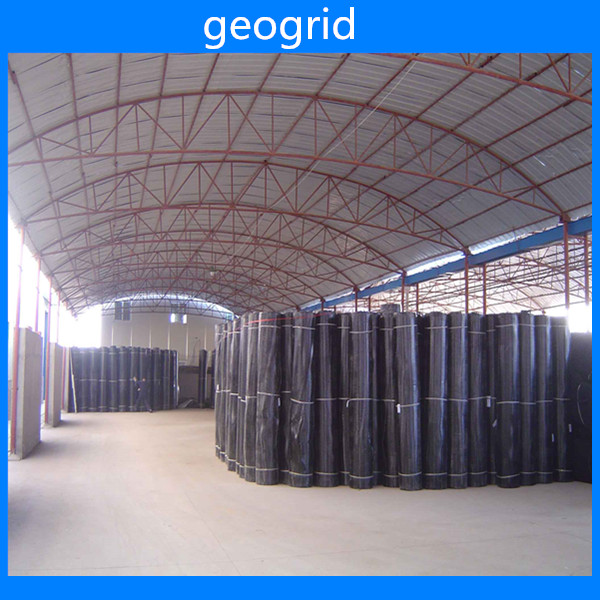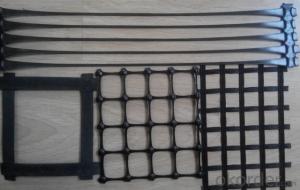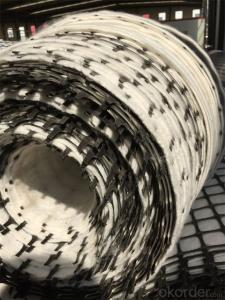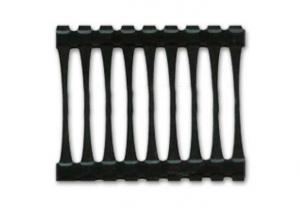Uni-directional Plastic Geogrid Slope Erosion Geocells
OKorder Service Pledge
OKorder Financial Service
You Might Also Like
Item:PP Uniaxal geogird
1.Material:PP
2.Tensiel strength:30KN/M
3.Size:2.5m*50M
4. Elongation:10%

Uniaxial geogrid ,made of high molecular polymer ,is extruded into sheet and then punched into regular mesh patten,and finally stretched in the longitudinal direction.

Feature:
With high tensile strength and tensile modulus
Function:
Uniaxial goegrid is mainly applied in highway,railway,slope protecting projects,retaining wall,dam to strengthen land loading capacity and extend its service life.Features in reducing area,project cost and matentainence cost,convenient to construct.

- Q: What are the procedures for using two-way geogrid
- 8 bidirectional geogrid construction methods: subgrade excavation, setting sand cushion (height of not more than 10cm), rolled into a platform, laying grille, longitudinal and main stress direction, the longitudinal joints 15-20cm, lateral 10cm, lashing plastic belt joint, and in the laying of the grille, every 1.5-2m with U the nail is fixed on the ground, laying geogrid should be timely backfill material, laying geogrid layers as technical requirements.
- Q: How to shop on the road surface of the two
- Each product has a link hole, we also have a professional link accessories. There are circular holes, there are flat holes.
- Q: Who can say the geogrid, fiberglass mesh and geotextile what is the difference, from the material function, the use of all aspects of speaking, if the answer is good, I add the score
- A grille is made of polypropylene, PVC polymer and thermoplastic or molded by two-dimensional grid or a certain height of the three-dimensional mesh screen, when used as a civil engineering, called geogrid. Engineering applications: highway, railway, bridge, road, pier, dam, slag field, such as soft soil foundation reinforcement, retaining wall and pavement crack resistance engineering and other fields.
- Q: How do geogrids improve the performance of reinforced soil structures?
- Geogrids improve the performance of reinforced soil structures by providing additional tensile strength and stability. These materials enhance the load-bearing capacity of the soil, prevent movement and settlement, and distribute the applied loads more evenly. Geogrids also minimize the potential for soil erosion and improve the overall durability and longevity of the reinforced structure.
- Q: How do geogrids improve the performance of geocomposites?
- Geogrids improve the performance of geocomposites by providing reinforcement and stabilization. They enhance the load-bearing capacity and tensile strength of the geocomposite, helping to prevent soil erosion and improve overall stability. Geogrids also increase the longevity and durability of the geocomposite, making it more resistant to deformation and damage.
- Q: What are the differences between geogrids and geocells?
- Geogrids and geocells are both geosynthetic materials used in civil engineering and construction projects, but they have some key differences. Geogrids are typically made from high-strength polymers and have a grid-like structure with open spaces. They are used to reinforce and stabilize soil, especially in applications like retaining walls, slopes, and roadways. Geogrids provide tensile strength and distribute loads, preventing soil erosion and enhancing stability. On the other hand, geocells are three-dimensional honeycomb-like structures made from various materials, such as high-density polyethylene (HDPE). Geocells are used for soil confinement and erosion control. They are filled with soil, aggregate, or other materials and create a stable platform for construction projects, such as roadways, load-bearing surfaces, and erosion control applications. Geocells offer excellent load distribution, erosion resistance, and confinement capabilities. In summary, while both geogrids and geocells serve as reinforcements in civil engineering projects, geogrids focus on providing tensile strength and load distribution, while geocells excel in soil confinement, erosion control, and load-bearing capabilities.
- Q: What is geogrid, what is the role?
- Glass fiber grille is made of high quality enhanced E-glass fiber yarn, woven into the substrate with the foreign advanced warp knitting, warp knitting with directional structure, make full use of the fabric yarn strength, improve its mechanical properties, so it has good tensile strength, tensile strength and creep resistance, planar network shaped material and high quality modified asphalt coating processing and into. The follow similar compatibility principle, highlighted with the composite performance of asphalt mixture, and fully protect the glass substrate, which greatly improves the wear resistance and anti shearing ability of the substrate, which can be used to enhance the resistance, cracks, rutting of highway asphalt pavement, the end of the problem is difficult to increase.
- Q: Are geogrids easy to install?
- Yes, geogrids are relatively easy to install. They can be installed using simple tools and equipment, and the process generally involves unrolling the geogrid, securing it in place, and covering it with soil or aggregate material. However, the ease of installation can vary depending on the specific project and site conditions.
- Q: What is the difference between uniaxial and biaxial geogrids?
- Uniaxial geogrids have strength and stiffness in one primary direction, typically in the machine direction. This means they provide reinforcement in one direction only. On the other hand, biaxial geogrids have strength and stiffness in both the machine direction and cross-machine direction, providing reinforcement in two perpendicular directions.
- Q: How do geogrids improve the performance of geotextile-reinforced slopes?
- Geogrids improve the performance of geotextile-reinforced slopes by providing additional tensile strength and stability. They act as a reinforcement material, increasing the load-bearing capacity and preventing soil erosion. Geogrids also enhance the overall slope stability by distributing stresses and reducing lateral movement of soil particles.
Send your message to us
Uni-directional Plastic Geogrid Slope Erosion Geocells
OKorder Service Pledge
OKorder Financial Service
Similar products
Hot products
Hot Searches
Related keywords
























